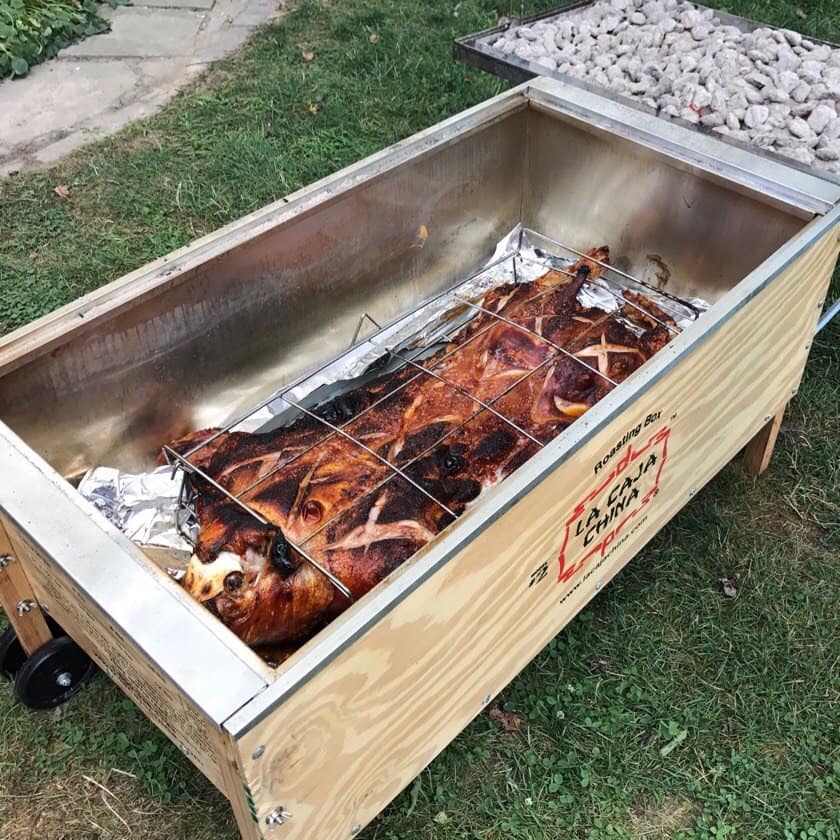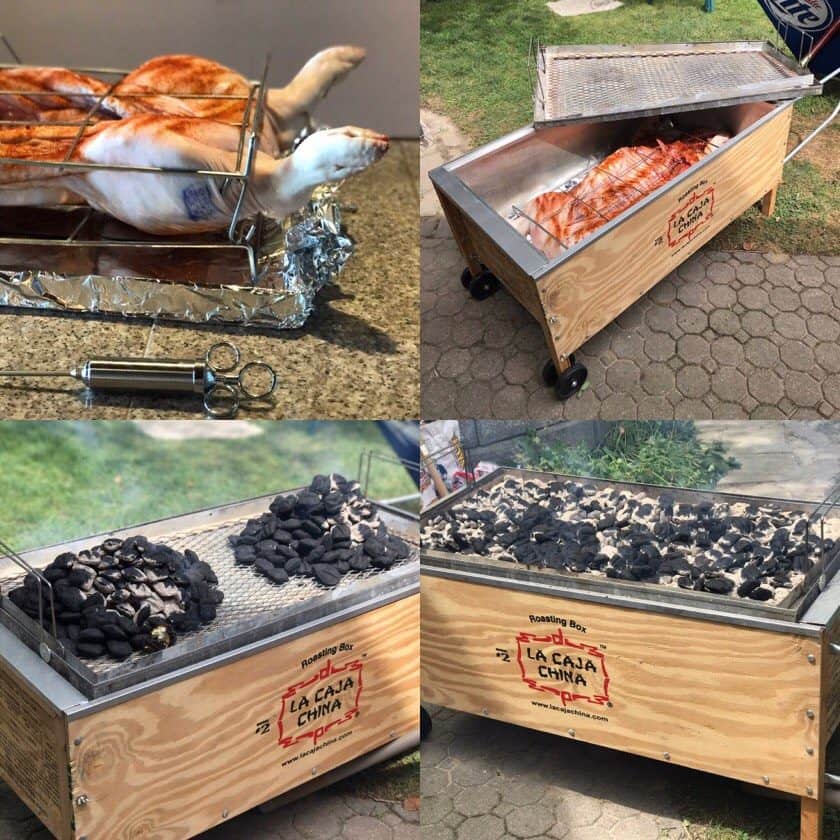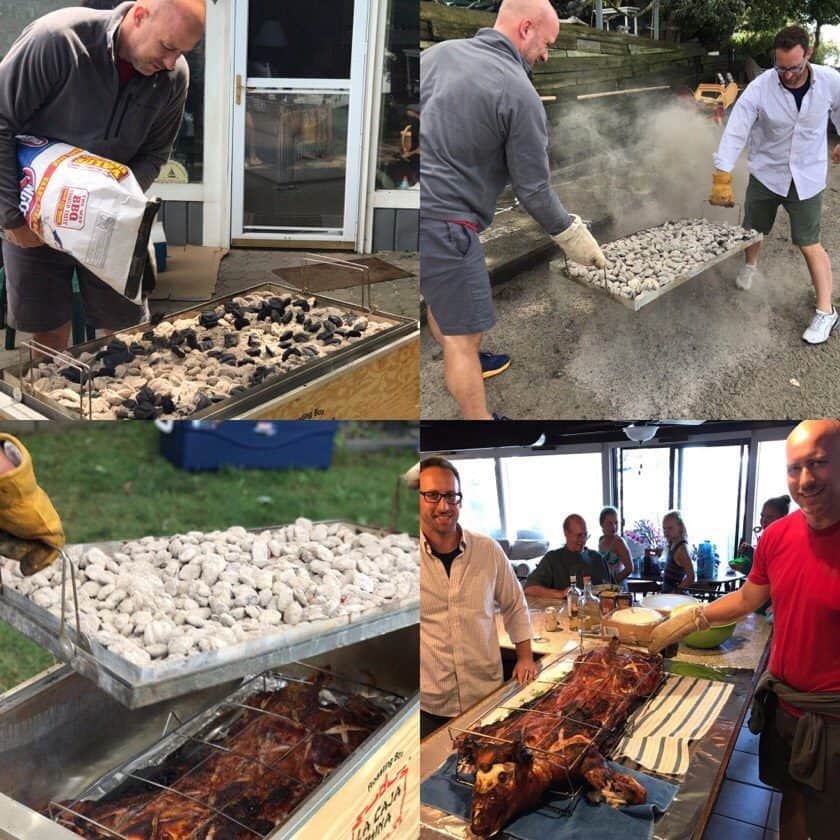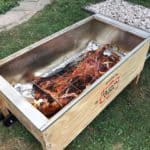Matt’s La Caja China Pig Roast

Years ago, he bought a La Caja China roasting box. Ever since, about once a year, he treats us with a pig roast. There’s nothing quite like inviting 30 friends over, dropping a whole pig on the kitchen island, and telling them: “dig in!”.

The roasting box is a metal lined wooden box. You dump a lot of charcoal on the lid - a LOT of charcoal - and the heat radiates through the metal lid, turning the box into a high heat roasting oven. The roasting box cooks a whole pig in about 3.5 hours, depending on the size of the pig. (50 to 100 pounds - a small pig - is about right for the large #2 size La Caja China). I’ve made some fantastic pork in my day, and this pig matches any of them.
Clockwise from top left: Pig in the roasting rack; pig in the box; starting the coals; adding more coals after an hour

For the last day of our cottage vacation, Matt ordered a 75 pound pig from the West Side Market and invited our extended family for a pig roast. I’ve been meaning to blog about Matt’s pig roasts for a while, so this was my big opportunity. I was there for the whole process and had time to help out and had time to take pictures while my brother Pat helped out with the cooking. (Sorry, guys!)
Clockwise from top left: Adding more coals; shaking out the ashes; peeking at the pig skin; ready to serve!
Having a second person to help is important. A whole pig is too large for one person to handle, especially when it is spread out in the roasting box's cooking grid. Now, don’t worry - a roasting box is surprisingly hands off. Most of the job is sitting around the roasting box and drinking beer while the pig roasts inside. Add some charcoal every hour; shake out the coals and flip the pig for the last 30 minutes to crisp up the skin. That’s it; after 3 ½ hours, you have a gorgeous roast pig to shock and awe your dining crowd.
Recipe: Matt’s La Caja China Pig Roast
Inspired by: Roast Pig instructions, La Caja China [lacajachina.com]
clock clock icon
cutlery cutlery icon
folder folder icon
instagram instagram icon
pinterest pinterest icon
facebook facebook icon
print print icon
squares squares icon
heart heart icon
heart solid heart solid icon

Matt’s La Caja China Pig Roast
5 Stars 4 Stars 3 Stars 2 Stars 1 Star No reviews
- Author: Mike Vrobel
- Total Time: 51 hours 30 minutes
- Yield: 38 servings 1 x
Description
Matt's La Caja China Pig Roast - cooking a 75 pound pig in a La Caja China roasting box.
Ingredients
Scale 1x 2x 3x
- 75 pound dressed pig (That is, cleaned and gutted. Will serve about 38 people.)
- Small Apple (to shove in the mouth - the teeth are sharp. Note that we forgot this in the pictures…)
- ¾ cup kosher salt (about ½ teaspoon per pound)
Rub (My homemade rub, or use 0.75 cup store bought rub)
- 4 tablespoons paprika
- 4 tablespoons brown sugar
- 2 tablespoons chili powder
- 1 tablespoon ground black pepper
- 2 teaspoons garlic powder
- 2 teaspoons onion powder
- 1 teaspoon dried thyme
Cook Mode Prevent your screen from going dark
Instructions
- Dry brine the pig: 24 hours to 2 days before cooking, sprinkle the pig with the salt, concentrating most of it on the meat side - that is, a little on the skin side, more on the meat side. Store the pig in a large cooler, covered with bags of ice. (Don’t open the bags - Replace bags as they melt. We swapped in a couple of big bags of grocery store ice every 24 hours.)
- Season the pig and spread it out in the roasting rack: The day of cooking, remove the pig from the cooler, pat it dry with paper towels as best you can, then spread the pig out on top of one of the roasting racks, skin side down. Sprinkle the meat side of the pig with the rub. Make sure the pig is spread open - we want it spread out as much as possible to cook evenly - and set the other roasting rack on top of the pig. Connect the racks with the s-hooks, sandwiching the pig between the racks. Set the drip pan in the roasting box, and then put the pig in the box, on top of the drip pan, skin side down.
- Cook the pig for 3 hours: Close the box with the ash pan and charcoal grid tray. Pour an entire 16-pound bag of charcoal into 2 big piles on top of the charcoal tray. Light the charcoal - this is one time when it’s OK to use lighter fluid, because the pig is protected from the flavor of the fluid in the box. When the charcoal is covered with ash, spread it out into an even layer over the entire charcoal tray, and start the cooking timer. After 1 hour of cooking spread 8 pounds of unlit charcoal over the top of the box. After 2 hours of cooking, spread another 8 pounds of unlit charcoal over the top. After another 30 minutes (2.5 hours of cooking), spread another 8 pounds of unlit charcoal over the top, and cook for 30 minutes more.
- Crisp the skin for 30 minutes: After 3 hours of cooking, have two people wearing hand protection lift the charcoal grid tray and shake out the coals into the ash pan. Carefully set the charcoal grid on the handles of the roasting box. Lift the ash tray off of the box and dump the ashes into a fire-safe container. Lift the charcoal grid off of the handles, slide the ash tray underneath, and set them both back down on the handles for now. Flip the pig in the box so the pig is skin side up. Set the ash tray and coals back on top of the box, closing it once more. Cook the pig for 30 minutes to crisp the skin. At that point, check the pig - lift the edge of the lid of coals and peek at the skin. If the skin is browned and crispy (and maybe blackening a little at the edges), it is done. Otherwise, keep cooking, peeking every 10 minutes or so, until the skin is browned and crispy.
- Serve: Again, wearing hand protection, have 2 people remove the ash pan and coals to the handles of the box. Grab the pig and carry it to a table (we cover a table in aluminum foil and then a layer of kitchen towels). Remove the top grid and set it aside, then let the pig rest for 15 to 30 minutes. To serve, you can let your guests tear into the pig themselves (our usual approach), or start “picking the pig” and shredding the meat yourself. (Don’t forget pieces of the crackling skin - they’re the best part.)
Notes




